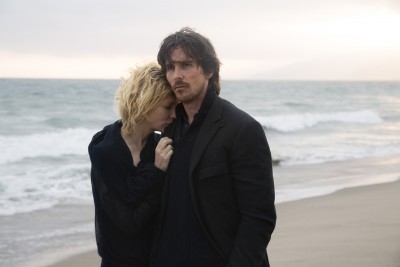
Konstantin Treplev would’ve loved Terrence Malick.
Treplev, a young, brooding playwright, spends much of “The Seagull” — the Anton Chekhov play of which he’s the focus — lamenting that there are no “new forms” of art that might allow observers a novel worldly perspective and incite them to change their ways of life.
Because “The Seagull” is a Chekhov play, this lamentation consumes him and he ends up shooting himself in the head. (For the record, Chekhov maintained throughout his entire life that “The Seagull” is a comedy.) Sitting where we do today, it’s hard not to wonder if the young artist might’ve held on a bit longer had he lived to see a latter-day Malick film.
Now, this is reductive, but only a bit. Malick’s output this decade — “The Tree of Life” in 2011, “To the Wonder” in 2012 and now “Knight of Cups,” which premiered last year in Berlin and just received U.S. distribution — forms sort of a loose trilogy with storylines that vary a great deal but with forms that are so unorthodox, they remain connected.
Working with cinematographer Emmanuel Lubezki, who just won his third consecutive Academy Award for his work with Alejandro G. Iñárritu on “The Revenant,” Malick has asked with these films a flurry of questions about the limits and purpose of cinema as a means of expression.
Each is obsessed with memory, but not in the straightforward way a film like “The Social Network” is. Rather, Malick’s trilogy is obsessed with documenting the very act of remembering.
Lubezki’s camera lurches and sways as Malick’s characters cavort, capturing moments with a destabilizing level of subjectivity. We see images out of order, landscape shots intercut with shots of interaction intercut with relevant childhood recollections.
Characters speak and we can’t quite make out what they’re saying. Despite the appearance of utter nonlinearity, there is an ephemeral but discernible thread propelling the action forward. There is often less of an arc than one would find even in a Bergman film. It can be alienating and confounding, and yet it gets under the skin precisely because it is so adept at capturing naturalistic mental processes that cinema often prefers to streamline.
“Knight of Cups” isn’t going to win any new converts from those put off by “To the Wonder” or the increasingly obscure trajectory of the man who brought us “The Thin Red Line.” It is, however, a fascinating refinement of Malick’s cinema of memory, even as its subject matter underwhelms.
Ostensibly, “Knight of Cups” tells the story of Los Angeles screenwriter Rick (Christian Bale) as he navigates a flurry of women and processes the untimely death of his younger brother. Wes Bentley shows up as his other, still-living brother, and Rick is tasked with looking after him for a bit.
“Knight of Cups” doesn’t care what its plot is. While previous Malick films could clearly fit into traditional narrative structures, even as they presented these structures in unorthodox ways, “Knight of Cups” is by far the most plot-less of Malick’s films.
Its title refers to a tarot card characterized by wandering, and the structure reflects that in spades. The film is divided into discrete chapters, all corresponding to a particular tarot card, and these chapters usually correlate to a particular woman in Rick’s life.
What works is the sheer beauty of some of these chapters. “Judgment,” the fourth chapter, centers around Rick’s distant marriage to a physician (Cate Blanchett), and the majesty of its construction cannot be overstated. It is a microcosm of years of erosion, and the way that the images stack themselves, the disconnect between what Blanchett says in voiceover and what we see onscreen sends chills up the spine even on recollection.
Equally affecting is an interlude featuring Natalie Portman as a married woman with whom Rick seems to find something approaching true contentment. While the film often borders on the fetishization of young, beautiful, mysterious women and the magnetic effects they have on ordinary men, it actually seems to ridicule Rick for taking this stance — he ruins the Portman relationship because he prefers observation to experience.
What doesn’t work is the played-out nature of a lot of Malick’s themes. He shows us Los Angeles as both a wasteland of fruitless hedonism and a glittering seductive utopia. While this depiction is visually compelling, the knee-jerk response is a bit of a shrug. There is little in this Los Angeles that we haven’t seen elsewhere, especially as Los Angeles relates to the ennui of well-off white men.
Also, rather than burying his religious and ancient influences in the visuals and structure of the film, Malick makes them explicit from the film’s opening seconds. “Knight of Cups” opens with a direct quote from a hymn in John Bunyan’s “The Pilgrim’s Progress” about a wanderer who has forgotten where he came from.
For all of the film’s quietness, it often clunkily announces what it is about so less attentive viewers can at walk away with a grasp on the thesis.
All of this is to say that we should commend Malick for stretching the boundaries of visual storytelling, and that he’s created something undeniably compelling in “Knight of Cups,” especially when taken with its two direct predecessors.
In watching these films, we come to somehow better understand the ways that our minds function and our memories affect us. The staggering beauty of some of the images is truly unforgettable.
However, taken on its own, “Knight of Cups” has a staying power that is undercut by its otherwise hackneyed material and unexciting characterization of Rick as “fragments of a man”— a phrase repeated no less than 10 times in the film’s duration.
One wishes that Malick had tackled something much more general or personal rather than remaining in a muddled, well-worn middle ground, even as the film commands attention.
Indeed, Treplev would’ve loved Malick, but I think he might’ve been mixed about “Knight of Cups.”




















































































































